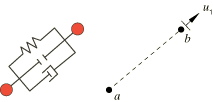AXIAL | |||||||||
|
| ||||||||
ProductsAbaqus/StandardAbaqus/ExplicitAbaqus/CAE
Description

The AXIAL connection does not constrain any component of relative motion. The distance between nodes a and b is
The available component of relative motion, , acts along the line connecting the two nodes, measures the change in distance separating the two nodes, and is defined as
where is the initial distance from node a to b. The connector constitutive displacement is
The kinetic force is
In Abaqus/Standard an optional orientation can be provided at one of the nodes in an AXIAL connection to provide direction for the force if the nodes are coincident or when one of the nodes is a “ground node.” If the orientation is provided at both of the coincident nodes, the orientation at the first node in the connectivity will be used. The orientation definitions remain fixed during the analysis and will be ignored when the two nodes separate. Rotational degrees of freedom are not activated for connection type AXIAL.
![]()
Summary
| ||||||||||||||||||||||||